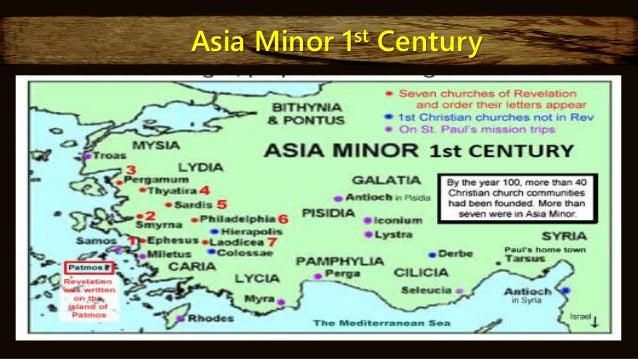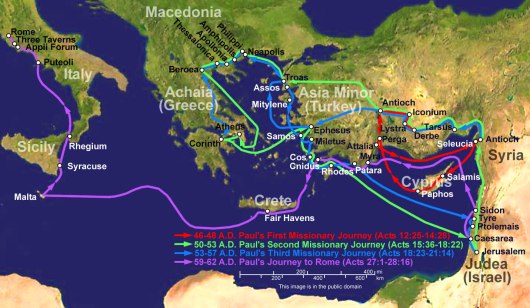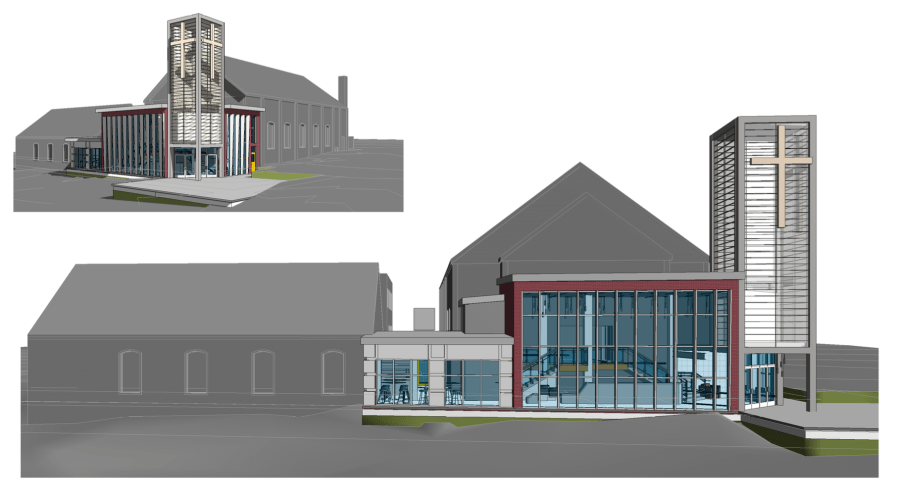“He that hath an ear, let him hear / respond to what the Spirit saith unto the churches.” Revelation 2:1-7

If we’re going to understand the prophetic value of these letters we need to know their historical reality.
“Unto the angel / Messenger of God / Prophet – Preacher of the church of Ephesus write: These things saith he that holdeth the seven stars in his right hand, who walketh in the midst of the seven golden candlesticks.”
This describes the actions of a regional religious leader who makes a regular circuit to support the offshoot churches, and informs us that The First Church of Asia had been successful in church planting.
Ephesus was at the time second only to Rome as a cosmopolitan center of culture and commerce...
Ephesus…was a Greek and Roman city. The Greeks came here about 3,000 years ago, right after the…Trojan War….At the end of the (10 year) war the…legendary leader of the Greeks…decided…to build a new city.
Ephesus had a major port located at the end of the famous Silk Road. So imagine all the goods brought here with the caravans, and then distributed to the then known world through this Ephesian port…
Apostle Paul…spent considerable time on his second visit, from 52 to 55 A.D., more than two years. (Acts 19:1- 41) The longest time Paul stayed in one place during his missionary journeys was Ephesus. Why did Paul pick this spot? Why John came here? What was the big deal for these two disciples in Ephesus? The population. Almost 300,000 people at its peak, and about 200,000 in the first century. We mentioned earlier that Ephesus was the western end of the Silk Road, which means it’s not only the goods, but also the words spread out very easily through this port. And the majority of the population of Ephesus were pagan (or gentiles). So it was a virgin territory for Christianity. In other words, that was the best place where Paul meant to be, having the opportunity, the chance, to convert a civilized Ephesus, which was the capital of the Asian province of the Roman Empire..
And this continued by the space of two years; so that all they which dwelt in Asia heard the word of the Lord Jesus, both Jews and Greeks.” (Acts 19:10)

The monotheistic Jews in the synagogues were disputing
- IF Yeshua of Nazareth was The Messiah prophesied by the prophets,
- IF resurrection was true, and
- HOW one attains righteousness to ensure a good experience after death.
The pagan Greeks and international peoples traipsing through this bottleneck trade route from the Far East had no problem believing any of this.
After all, resurrection to godhood had happened to many of their heroes like Gilgamesh, Alexander the Great and the Caesars. Accepting the resurrection of Yeshua of Judea – with a cultural twist – into their pantheon of existing gods and goddesses was business as usual for the Greeks.
The problem that the Gentile Ephesians had with Paul was NOT believing in Yeshua of Nazareth as the son of YHVH, but excluding all other gods for the worship of only YHVH.
“ye see and hear, that not alone at Ephesus, but almost throughout all Asia, this Paul hath persuaded and turned away much people, saying that they be no gods, which are made with hands [as fit vessels for the spirits of the gods]: So that not only this our craft is in danger to be set at nought; but also that the temple of the great goddess Diana should be despised, and her magnificence should be destroyed, whom all Asia and the world worshippeth. And when they heard these sayings, they were full of wrath, and cried out, saying, Great is Diana of the Ephesians.” (Acts 19:26-28)

Since prehistoric times the site of Ephesus was a place of pilgrimage for the worship of the Eastern mother goddess, reflected in the sexual rather than philosophical orientation of its religion, called in the Greek tongue Athena or Diana, twin sister of Apollo. This tourism and standard trading benefited greatly by a water route into the hinterland up the Meander River.
Diana’s status in Asia Minor can be calculated by the wealth poured into her temple, which was the largest Greek temple built in its day. It took 100 years to build, and was ranked among the Seven Wonders of the World. “Apart from Olympus, the Sun never looked on anything so grand,” the writer Antipater of Sid whom the on wrote of the Temple of Artemis at Ephesus. Steps soared to a 400-foot-long terrace flanking 127 60-foot marble columns and a statue of the goddess.
most people in the ancient world made vows to gods to achieve specific, well-defined, short-term goals, such as avoiding illness, ensuring a bountiful harvest, completing a voyage safely, getting rich, or attracting a desirable lover. If the goal was realized, the person who made the vow dedicated a statue or an inscription . . . to the god(s) to pay off the vow.” Rogers refers to this process as…“I give so that you might give,” creating with the gods, he writes, “a reciprocal relationship…
This standard MO is part of Paul’s teaching to Gentiles newly converted from paganism to YHVH’s Savior:
“who hath first given to him, and it shall be recompensed unto him again? For of him, and through him, and to him, are all things.” (Romans 11:35-36)
Ephesus’ nickname was “Lumen / Light of Asia”. This is referenced in YHVH’s Savior’s intro to the letter to this congregation where he reminds her that he holds and keeps the lights lit. The clear message here is that they need to stay connected to him in their constant struggle to be drawn into connection with Diana. A comparable opening to a letter to a church in NYC might reference biting into beautiful appearing but wormy apple.
“I have somewhat against thee, because thou hast left thy first love. Remember therefore from whence thou art fallen, and repent, and do the first works; or else I will come unto thee quickly, and will remove thy candlestick out of his place.” (Revelation 2:4-5)
Jesus called the church of Ephesus a candlestick for good reason.
It was the New York City of Asia Minor in the New Testament era. Pliny once called it, lumen Asiae, the light of Asia.1 In the first centry, only Rome [Roman capitol], Alexandria [Egyptian capitol] and Antioch of Syria [capitol of Greek territory of Asia Minor] surpassed Ephesus in importance. It is no wonder that the apostle Paul made it the center of his ministry for three years (Acts 20:31). In fact, outside of the church in Jerusalem, one could argue that the church in Ephesus was the most prominent congregation in the first forty years of church history. [Emphasis added.] From its beginnings in Acts 19 circa 52 AD, to Rev. 2, as late as 90 AD, the church in Ephesus figures prominently in Scripture as the setting for the books of Ephesians, 1 and 2 Timothy, and possibly the epistles of John. It also enjoyed some of the greatest Bible teachers of its day, including Paul, Apollos, Aquila and Priscilla, Timothy and John. Given the number of verses written to Ephesus or from Ephesus (ie. 1 Corinthians), we know more about it than almost any other city mentioned in the New Testament.
It was through the Jews that Christianity was first introduced into Ephesus. The original community was under the leadership of Apollo ( 1 Corinthians 1:12 ). They were disciples of St. John the Baptist, and were converted by Aquila and Priscilla. Then came St. Paul , who lived three years at Ephesus to establish and organize the new church…
If we base our analysis on the biblical record, their first love can only be of Paul’s teaching.
“And [Paul] came to Ephesus…he himself entered into the synagogue, and reasoned with the Jews...they desired him to tarry longer time with them, he consented not…saying, I must by all means keep this feast that cometh in Jerusalem: but I will return again unto you, if God will…And a certain Jew named Apollos, born at Alexandria, an eloquent man, and mighty in the scriptures, came to Ephesus. This man was instructed in the way of the Lord and being fervent in the spirit, he spake and taught diligently the things of the Lord…For he mightily convinced the Jews, and that publicly, shewing by the scriptures that Jesus was Christ…Paul…came [back] to Ephesus…and he went into the synagogue…But when divers…spake evil of that way [Jewish sect of YHVH’s Savior] before the multitude, he departed from them, and separated the disciples, disputing daily in the school of one Tyranny’s…by the space of two years…all they which dwelt in Asia heard the word of the Lord Jesus, both Jews and Greeks…So mightily grew the word of God and prevailed…And the same time there arose no small stir about that way.” (Acts 18:19-28, 19:1-23)
Ephesus’ first bishop was Timothy, who Paul had expressly confirmed a Jew for the purpose of reaching Jews. Under Paul’s direct guidance it grew and multiplied, as in Antioch, with both circumcised Jews and uncircumcised Gentiles accepted into the assembly.
Many Christians & Jews are unaware of the fact that for the first 40 years (up to 70 AD) after Yeshua (Jesus) ascended into heaven, to sit at the right hand with all Power & Authority, believers in Yeshua were predominately Jewish. These Jewish believers still followed Torah, kept Kosher, kept Shabbat, and worship in the Temple and synagogue…
believing & non-believing Jews coexisted, sitting in the same synagogue, and attending the same temple….Jerusalem was between 1/3 & ½ believers in Yeshua before the destruction of the Temple…While many Jews did not agree that Yeshua was Messiah, they respected the believers for their lifestyle & devotion.
Then, almost 20 years later, knowing that the mother church at Jerusalem was about to be smashed and scattered, Paul wrote his literary and doctrinal masterpiece on the form and function of joint Jewish-Gentile leadership. This was the first time this doctrine was articulated. Ephesus’ location and sphere of influence made their assembly the logical one to pick up the reigns of leadership torn away from Jerusalem after 70 AD.
From where had they fallen? Their first love.
First love is an impetuous force that drives actions from the heart. This is so contrary to human nature that it needs to be continuously re-energized by actions from the heart, or it gets lost over time, gradually replaced by a cost-benefit analysis calculating what’s best for the giver or returns the highest numbers.
“Wherefore remember, that ye being in time past Gentiles in the flesh…aliens from the commonwealth of Israel, and strangers from the covenants of promise…But now in Christ Jesus ye who sometimes were far off are made nigh by the blood of Christ...For through him we both have access by one Spirit unto the Father. Now therefore ye are no more strangers and foreigners, but fellowcitizens with the saints, and of the household of God; And are built upon the foundation of the apostles and prophets, Jesus Christ himself being the chief corner stone…In whom ye also are builded together for an habitation of God through the Spirit.” (Ephesians 2:11-22)
But Paul’s letter went over like a lead balloon. Paul’s second letter to Timothy reports that not only the Ephesian church but the entire region under its leadership had turned away from him and his doctrine of unity between Israelite and Gentile believers.
“To Timothy, my dearly beloved son…thou knowest, that all they which are in Asia be turned away from me…I charge thee therefore…do the work of an evangelist, make full proof of thy ministry [as Paul’s heir “to bear my name before the Gentiles, and kings, and the children of Israel: Acts 9:15)
Evidently Timothy had been voted out of the church’s pastorship.
“Do thy diligence to come shortly unto me: For Demas hath forsaken me, having loved this present world…And Tychicus have I sent to Ephesus.” (II Timothy 1)
If you can’t feel how Paul’s desperate aloneness doesn’t resonate with Jesus’ own, then you’ve never experienced abandonment like this.
“Then cometh Jesus with them unto a place called Gethsemane…and he took with him Peter and the two sons of Zebedee, and…saith he unto them, My soul is exceeding sorrowful, even unto death: tarry ye here, and watch with me. ..And he cometh unto the disciples, and findeth them asleep, and saith unto Peter, What, could ye not watch with me one hour?” (Matthew 26:36-40)
History validates the deduction that the church at Ephesus had fallen away from Paul’s doctrine that the church of God is a sect of Judaism composed of uncircumcised Gentiles identified with circumcised Jews as followers of Jesus the Christ.
Many Christians & Jews are unaware of the fact that for the first 40 years (up to 70 years) after Yeshua (Jesus) ascended into heaven, to sit at the right hand with all Power & Authority, believers in Yeshua were predominately Jewish. These Jewish believers still followed Torah, kept Kosher, kept Shabbat, and worship in the Temple and synagogue…
believing & non-believing Jews coexisted, sitting in the same synagogue, and attending the same temple….Jerusalem was between 1/3 & ½ believers in Yeshua before the destruction of the Temple…While many Jews did not agree that Yeshua was Messiah, they respected the believers for their lifestyle & devotion.
The first major split occurred between 68-70 AD/CE. As Roman armies gathered to besiege Jerusalem , Believers were able to flee the city, heeding Yeshua’s words in Matt 24…This action labeled the believers as traitors in the eyes of many Jews…
Soon after 70 AD, [Jewish] Christians returned to Jerusalem…meeting at the “Church of the Apostles” on Mount Zion, near the Roman military camp (Cyril of Jerusalem; Epiphanius, Treatise on Weights and Measures; Itinerarium Egeriae; Eusebius, Ecclesiastical History).
However…[in the next generation] a major rebellion surfaced again. The Bar Kokhba revolt seems to have been inflamed by the plans of Emperor Hadrian to include Roman temples in the rebuilding of Jerusalem, and particularly upon the site of the Temple of Yahweh, which was revealed when he visited the city around 130 AD…Yet, the reasons for Hadrian coming to Jerusalem and rebuilding the city seem to be connected with his mission to defeat Christianity [emphases here and below added]. Earlier in his reign, Hadrian had begun to devise plans to eradicate Christianity from the Roman Empire due to its beliefs and worldview that were completely opposite to the pagan Roman way of thinking, and its rapid spread across the Empire in all social classes over the last several decades…Hadrian believed that Christianity could be more effectively eliminated through ideological policies rather than executions…hoping to defeat Christianity intellectually and syncretizing the worship of Christ into the Roman pantheon, apparently even offering to place a statue of Christ in Rome (Golan, “Hadrian’s Decision to Supplant Jerusalem by Aelia Capitolina”).
However, the Christians rejected this offer of syncretism and modification of Christianity into a part of the Roman religious system. The failure seems to have spurred Hadrian to attempt another strategy, involving the paganization of sites related to Jesus and Christianity. Knowing that Jerusalem had been central to Jesus and Christianity, Hadrian went to the city with this new plan. Rebuilding Jerusalem and founding it as a Roman colony in place of the ruins, Hadrian renamed the city Aelia Capitolina in honor of his family name and the god Jupiter. The province was expanded and renamed Syria Palaestina, supplanting Israel with Philistia. While this act certainly erased historical associations, it also directly challenged Jesus and Christianity by making the very name of the city into a Roman deity and Emperor, attempting to show the supremacy of Rome, its gods, and its Emperor…sites in the area which had an association with Jesus which Hadrian had pagan temples and shrines built over include the birthplace of Jesus in Bethlehem, the Pool of Bethesda, and the Pool of Siloam…
Soon after Hadrian left the area, full scale revolt began…further depopulated Judea, with tens of thousands slain and many cities and towns ruined. Cassius Dio even remarked that wolves and hyenas howled in the cities (Cassius Dio, Roman History; cf. Isaiah 13:22). Jerusalem itself was apparently besieged again during the reign of Hadrian…Christians did not support either of the revolts in Judea, and Eusebius recorded that many Christians suffered torture and death when they refused to join the Bar Kokhba revolt and attack Roman soldiers (Eusebius, Chronicon; Justin Martyr, Second Apology; Orosius, History). After over three years of fighting (132-136 AD), the Romans subdued the rebels and their false messiah Simon Bar Kokhba, who was executed along with other leaders of the rebellion. The effect of the rebellion was devastating to Judaism and the entire land of Judea, including the erasure of the ancient names and associations with Israel and Judah, the banning of the Mosaic Law, and the execution of many leaders of Judaism. For Jerusalem in particular, Hadrian completely banned Judaism in the city and barred Judeans from entering Jerusalem except once a year on Tisha B’Av (9th of the month Av), the day commemorating the destruction of the Temple in 70 AD. [but] the city remained a place of both pagan and Christian worship.
The destruction of the Temple and the ostracism of Messianic Jews who bailed rather than support the rebellion in 70 AD broke the power base of Messianic Judaism.
Banning the practice of Judaism in Palestine in 136 finished it off.
We should also expect that the wrath of Rome against the Jews would make the average Gentile Christian shy away from any association with them. Unlike some of those suicidal pastors in Germany under the Nazis, they didn’t need to add the Jewish question to their troubles. They were experiencing their own tribulation.
From what did they need to repent?
“This thou knowest, that all they which are in Asia be turned away from me…the things that thou hast heard of me among many witnesses the same commit thou to faithful men…In meekness instructing those that oppose themselves; if God peradventure will give them repentance to the acknowledging of the truth; (II Timothy 3)
What were their first works? “So mightily grew the word of God and prevailed.” (Acts 19:8-20)
Thirty years later the assembly at Ephesus and her satellite churches were still solidly Jewish. Would they respond to John’s letter more positively than to Paul’s?
“I know thy works, and thy labour, and thy patience, and how thou canst not bear them which are evil: and thou hast tried them which say they are apostles, and are not, and hast found them liars: And hast borne, and hast patience, and for my name’s sake hast laboured, and hast not fainted.
Nevertheless I have somewhat against thee…thou hast left thy first love…Remember therefore from whence thou art fallen, and repent, and do the first works; or else I will come unto thee quickly, and will remove thy candlestick out of his place.” (Revelation 2:5-6)
The primacy of this church – not the one in Rome – can be seen in the fact that Jesus sent his last apostle, John, to shore up their ministry after he was released from the nearby island of Patmos. Clement of Alexandria, writing towards the end of the second century reports “about the Apostle John…when, on the tyrant’s death, he returned to Ephesus from the isle of Patmos, he went away, being invited, to the contiguous territories of the nations, here to appoint bishops, there to set in order whole Churches, there to ordain such as were marked out by the Spirit.” Timothy was welcomed back as bishop. Various traditions report that Paul’s devoted disciple Onesimus, a former slave, became the bishop of Ephesus.
“But this thou hast, that thou hates the deeds of the Nico-laitanes, which I also hate.” Revelation 2:6)
The Nicolaitanes are the charter members of the Roman Catholic Church.
For some time the leaders of the Ephesian were sound in Paul’s doctrine, demonstrated by the First Council of Ephesus.
In 190 Polycrates, bishop of Ephesus, convened a synod to establish…the date of the Jewish Passover as the official date of Easter. Pope Victor I…repudiated the decision and separated those who disagreed from Rome.
In 200, the same Polycrates rebuked a bishop of Rome, writing to remind him of notable men who maintained church customs, “not deviating in the least but following the rule of the Faith” and quoting “We must obey God rather than men”
In the 4th century the nationalization of Christianity under Constantine paved the way for compromise, demonstrated in the complicated maneuverings at the Second and Third Councils of Ephesus in the 5th century. By the 6th century the harbor had silted up and the city faded into obscurity.
The ruin of Ephesus was completed by Timur-Leng / Tamerlane in 1403 and by nearly a half-century of civil wars among its Turkish masters…in 1439 Mark of Ephesus (Marcus Eugenicus)…was the pastor of a miserable village, all that remained of the great city which Pliny once called…lumen Asiae.

